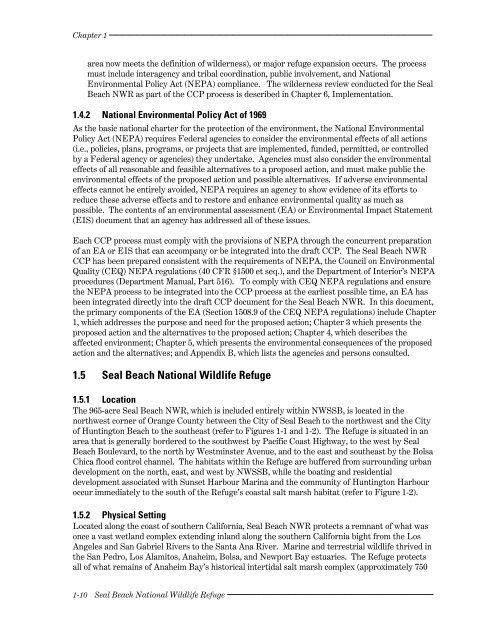Chapters 1 - U.S. Fish and Wildlife Service
Chapters 1 - U.S. Fish and Wildlife Service
Chapters 1 - U.S. Fish and Wildlife Service
You also want an ePaper? Increase the reach of your titles
YUMPU automatically turns print PDFs into web optimized ePapers that Google loves.
Chapter 1 <br />
area now meets the definition of wilderness), or major refuge expansion occurs. The process<br />
must include interagency <strong>and</strong> tribal coordination, public involvement, <strong>and</strong> National<br />
Environmental Policy Act (NEPA) compliance. The wilderness review conducted for the Seal<br />
Beach NWR as part of the CCP process is described in Chapter 6, Implementation.<br />
1.4.2 National Environmental Policy Act of 1969<br />
As the basic national charter for the protection of the environment, the National Environmental<br />
Policy Act (NEPA) requires Federal agencies to consider the environmental effects of all actions<br />
(i.e., policies, plans, programs, or projects that are implemented, funded, permitted, or controlled<br />
by a Federal agency or agencies) they undertake. Agencies must also consider the environmental<br />
effects of all reasonable <strong>and</strong> feasible alternatives to a proposed action, <strong>and</strong> must make public the<br />
environmental effects of the proposed action <strong>and</strong> possible alternatives. If adverse environmental<br />
effects cannot be entirely avoided, NEPA requires an agency to show evidence of its efforts to<br />
reduce these adverse effects <strong>and</strong> to restore <strong>and</strong> enhance environmental quality as much as<br />
possible. The contents of an environmental assessment (EA) or Environmental Impact Statement<br />
(EIS) document that an agency has addressed all of these issues.<br />
Each CCP process must comply with the provisions of NEPA through the concurrent preparation<br />
of an EA or EIS that can accompany or be integrated into the draft CCP. The Seal Beach NWR<br />
CCP has been prepared consistent with the requirements of NEPA, the Council on Environmental<br />
Quality (CEQ) NEPA regulations (40 CFR §1500 et seq.), <strong>and</strong> the Department of Interior’s NEPA<br />
procedures (Department Manual, Part 516). To comply with CEQ NEPA regulations <strong>and</strong> ensure<br />
the NEPA process to be integrated into the CCP process at the earliest possible time, an EA has<br />
been integrated directly into the draft CCP document for the Seal Beach NWR. In this document,<br />
the primary components of the EA (Section 1508.9 of the CEQ NEPA regulations) include Chapter<br />
1, which addresses the purpose <strong>and</strong> need for the proposed action; Chapter 3 which presents the<br />
proposed action <strong>and</strong> the alternatives to the proposed action; Chapter 4, which describes the<br />
affected environment; Chapter 5, which presents the environmental consequences of the proposed<br />
action <strong>and</strong> the alternatives; <strong>and</strong> Appendix B, which lists the agencies <strong>and</strong> persons consulted.<br />
1.5 Seal Beach National <strong>Wildlife</strong> Refuge<br />
1.5.1 Location<br />
The 965-acre Seal Beach NWR, which is included entirely within NWSSB, is located in the<br />
northwest corner of Orange County between the City of Seal Beach to the northwest <strong>and</strong> the City<br />
of Huntington Beach to the southeast (refer to Figures 1-1 <strong>and</strong> 1-2). The Refuge is situated in an<br />
area that is generally bordered to the southwest by Pacific Coast Highway, to the west by Seal<br />
Beach Boulevard, to the north by Westminster Avenue, <strong>and</strong> to the east <strong>and</strong> southeast by the Bolsa<br />
Chica flood control channel. The habitats within the Refuge are buffered from surrounding urban<br />
development on the north, east, <strong>and</strong> west by NWSSB, while the boating <strong>and</strong> residential<br />
development associated with Sunset Harbour Marina <strong>and</strong> the community of Huntington Harbour<br />
occur immediately to the south of the Refuge’s coastal salt marsh habitat (refer to Figure 1-2).<br />
1.5.2 Physical Setting<br />
Located along the coast of southern California, Seal Beach NWR protects a remnant of what was<br />
once a vast wetl<strong>and</strong> complex extending inl<strong>and</strong> along the southern California bight from the Los<br />
Angeles <strong>and</strong> San Gabriel Rivers to the Santa Ana River. Marine <strong>and</strong> terrestrial wildlife thrived in<br />
the San Pedro, Los Alamitos, Anaheim, Bolsa, <strong>and</strong> Newport Bay estuaries. The Refuge protects<br />
all of what remains of Anaheim Bay’s historical intertidal salt marsh complex (approximately 750<br />
1-10 Seal Beach National <strong>Wildlife</strong> Refuge

















